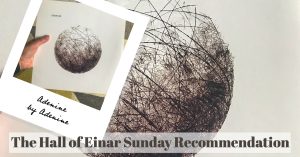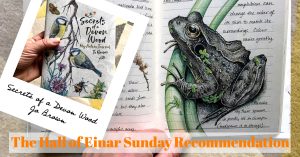The Hall of Einar – Sunday Review #4
Hello and welcome to my Sunday Review. Every week I read great wildlife and nature books, see engrossing websites and hear wonderful new music – this is my chance to bring you all the best I’ve experienced – every Sunday.
This week it’s the card game Little Songbirds, and a forthcoming book, Diary of a Young Naturalist, by Dara McAnulty:
Piepmatz – Little Songbirds – card game
Piepmatz is a card game which says all the right things on the box. “A card game for the whole family”, it says, as well as “Ein Kartenzpiele für die ganze Familie.” The rule for card games seems to be that if the rules are in German, it’s a very good and very popular game. Card and board games seem to be a much greater industry in Germany than they are in the UK.
Little Songbirds is for two to four players, takes 30 minutes (presumably when you’re better at it) and is for ages 10 and up. It’s a game created by Matt Riddle and Ben Pinchback.

What’s in the box?
There are 110 cards and a rulebook in English and a rulebook in German. The cards are well made and in a traditional style. It’s a little beige if you ask me. Some of the birds are brilliantly coloured and the design could have been really fresh and modern. Instead, it looks very traditional.
How do you play?
The game is based around a garden bird feeder with seeds in a column above it. You have a hand of four birds and you can add them to the queue waiting at a perch on the bird feeder. That queue forms pressure on the bird at the feeder. When the queue of birds has a total of points which is greater than the bird at the feeder, that knocks that bird off its perch and into your scoring pile. The highest point bird in the queue takes its place and the points-check repeats until the bird on the perch is secure again.
It’s a classic set collecting game. Points are earned from collecting seeds, collecting matched pairs of birds and from all the points from birds of the same kind, but, this is important, only if you have the most of them.
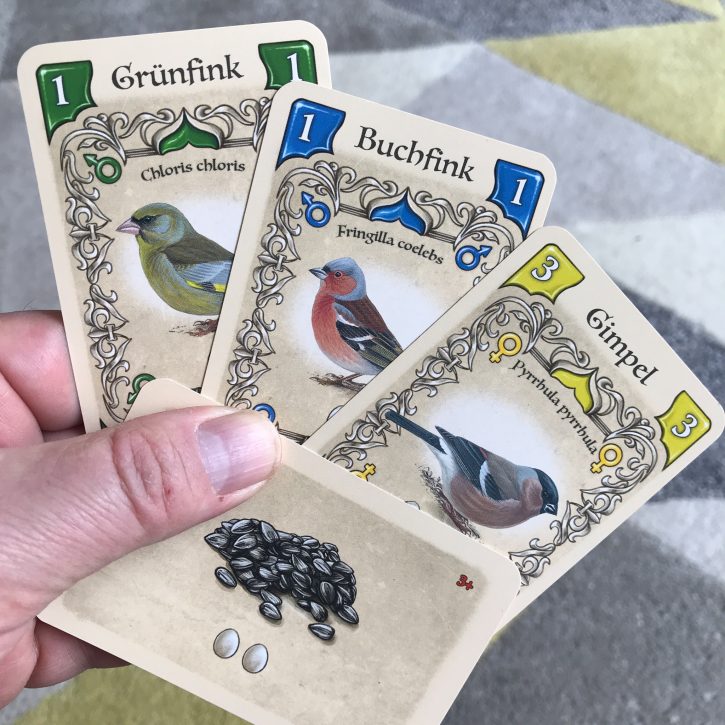
It’s a great game mechanic. You could be collecting Greenfinches all game and have loads of points but they might score nothing if your opponent has more Greenfinches than you. That’s relevant to my experience in playing it.
Piepmatz is a great game and there’s plenty to get used to in the rules. Once you understand the game mechanics, then comes the strategy. The brilliant thing about the game is the introduction of crows and squirrels. These attach themselves to seeds so that you could get a penalty for winning seeds. Having spent the start of the game trying to get high point-value birds in your hand, suddenly you want low point-value birds so someone else can lose cards or points from the crows and squirrels.
Here’s the game in action. I had a game with my mum, before the lockdown. She has no idea that she’s a genius.
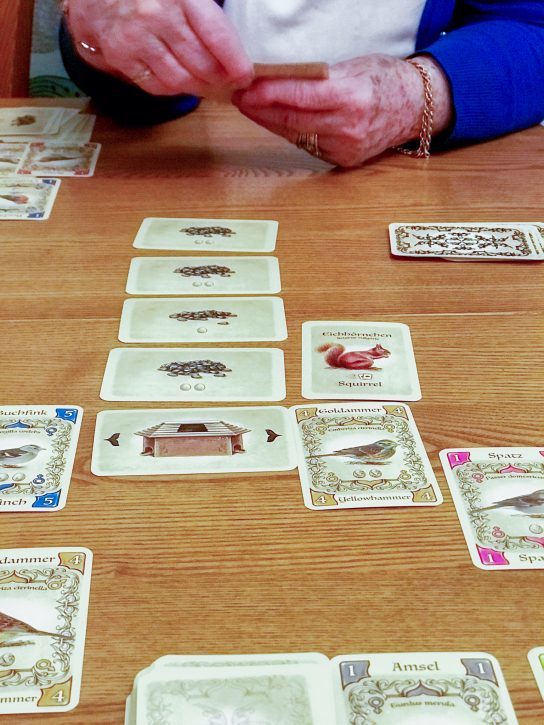
What’s wrong with it?
Precious little. The game mechanics are fabulous, the change in strategy needed is masterful and those pesky crows and squirrels introduce just the right amount of peril. The cards themselves might be a little too porridge coloured and the backs are uninspired, but it doesn’t detract that much. It’s also a game you need to play on a large table. Moving all those birds up close to the feeder, shuffling the seeds and crows and squirrels down and keeping your scoring cards in order is fussy. Don’t take it on a train and attempt to play on a train table. Clear the table first, and it’s best played on a table-cloth so cards don’t slide everywhere.
How did my game go?
I was winning until the final moment. At the end of the game you discard two cards from your hand of four and add the other two to your score pile. And, just like that, my mum got more of one bird than I did, meaning mine scored nothing. And I lost. I told you she is a genius, didn’t I?
I highly recommend Piepmatz.
In these indoor times, it’s a great way of having family fun, with interest and challenge all the way. I’m glad I bought it. I got my copy from Fan Boy Three in Manchester. It’s currently closed, the staff are furloughed and waiting for better times. Good luck to them.
What better way to spend time indoors with loved ones than a great card game? If you get it, let me know what you think.
Diary of a Young Naturalist – Dara McAnulty
It’s not out yet, you have to wait until 25 May for that, but I did manage to get hold of a free advance proof copy of Dara McAnulty’s first book, Diary of a Young Naturalist. In Diary of a Young Naturalist, Dara McAnulty is a 15 year old boy detailing his life and connection with nature through his particular view of the world.
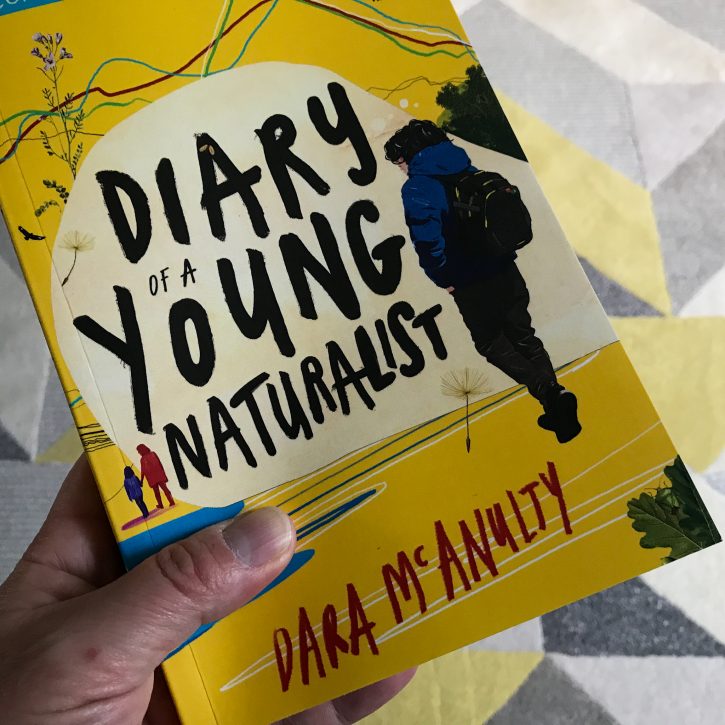
What’s it like to have a deep-seated love of nature and yet feel alienated from aspects of society by your autism? This is a great chance to find out.
Dara is someone I follow on Twitter. I thought it would be interesting to read to compare what life was like in nature, technology and in teenage years for me, and is like for Dara, forty years apart. I was a child who kept detailed nature notebooks and I’ve been sad to see how depleted our world has become in my lifetime and thrilled to see how many young people are like I was. I find him inspiring.
When I spotted that Little Toller press had a few uncorrected proof copies of Diary of a Young Naturalist available for review, many months before publication, I dropped them a line and they sent me a copy. So here’s my review.
Dara’s an interesting person and knows how to craft a tweet in limited Twitter characters, but can he write? I mean really write? Can he sustain a story? Can he use figurative language to allow an insight into his world and the natural world, that makes us see things with different eyes. Can he transport us, transfigure the world or enthral us? Or is this just a cynical exploitative ploy by a capitalist world desperate for novelty, ready jump on any trend and fleece it? Is this just an exercise in marketing. “The Irish Greta Thunberg? The new Chris Packham? He’s autistic as well, don’t you know?”
In short, does it have lasting worth? I was fascinated to find out whether Dara has enough insight into himself to have learned something by the end. And will I understand something about my own life by reading it? Or is it just designed to sell?
It starts with a great cover, replete with symbols. An oak leaf, a shied bug, a male blackbird, a floating dandelion seed, and Dara with a backpack. I open the book near the front and the first words I see are ‘severe flatulence’. It’s their greyhound at fault, if you were wondering. Maybe it would have been better if that was typeset on a final or second line, and not at the top of a page?
Dara’s diary starts on 21 March, the spring equinox, the start of the ancient calendar year, before this new-fangled idea of the first day of January came into use. I like that. Then Dara’s prose starts. Each entry is a tangled web of thoughts and feelings, impressions and passions, each with a purpose. The sensory overload, the difficulty in social situations, the odd coping strategies and the underlying love of nature come through in each day’s entry.
The structure of each section is one of the personal and the domestic, followed by anxiety and troubling thoughts, followed by a natural experience, culminating in peace of mind and the use of nature as a metaphor. It’s a compelling structure which delivers time after time.
I know he’s going to talk about a corncrake just from his description, and, sure enough, he is. I feel emotional imagining being there, imagining a bird flying from Africa to call all night for a mate and then have its family minced in machinery.
Diary of a Young Naturalist is clearly written by a teenager, and is all the more appealing because of it. Dara uses screamers (exclamation marks!!) and parentheses (brackets) in a jubilant style only a teenager could muster and use convincingly. It suits the content. As Autumn begins I’m hooked. I care about him. I want him to be okay at his new house. I want him to fit in at his new school.
Is it worth reading?
I’m so pleased I got a copy of Diary of a Young Naturalist. If it was a lesser book I would never have finished it. It managed to make me empathise with Dara and his daily struggles and the release he finds in nature. It’s cleverly structured throughout to reveal insights into his and the natural world.
I highly recommend it. It’s sure to be a big seller for Little Toller books. I’m also pleased to see Little Toller are still able to function in safety during lockdown and they are taking pre-orders for Diary of a Young Naturalist – and they don’t charge postage in the UK. If you’re interested, please support them directly and buy from them. They also have other fabulous books in print. Take a look at their inspiring catalogue if you have some time on your hands.
That’s it for this week.
I’ll be back with more reviews of things you might adore next Sunday.
More Sunday Reviews
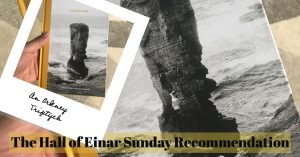 The Hall of Einar Sunday Recommendation #23 An Orkney Triptych - Book One by Erland Cooper and Alex Kozobolis read more
The Hall of Einar Sunday Recommendation #23 An Orkney Triptych - Book One by Erland Cooper and Alex Kozobolis read more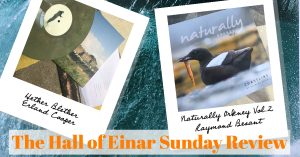 The Hall of Einar Sunday Review #20 Hether Blether by Erland Cooper and Naturally Orkney Vol.2 - Raymond Besant read more
The Hall of Einar Sunday Review #20 Hether Blether by Erland Cooper and Naturally Orkney Vol.2 - Raymond Besant read more The Hall of Einar Sunday Review #19 Feather by Edgelarks and Pony Congo by Vicente Paredes. read more
The Hall of Einar Sunday Review #19 Feather by Edgelarks and Pony Congo by Vicente Paredes. read more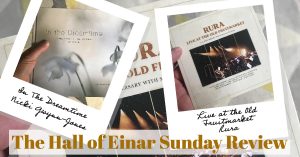 The Hall of Einar Sunday Review #17 In The Dreamtime by Nicki Gwynn-Jones and Live at the Old Fruitmarket by Rura read more
The Hall of Einar Sunday Review #17 In The Dreamtime by Nicki Gwynn-Jones and Live at the Old Fruitmarket by Rura read more The Hall of Einar Sunday Review #16 Fungi – card game by Brent Povis and Collins British Mushrooms & Toadstools photographic guide read more
The Hall of Einar Sunday Review #16 Fungi – card game by Brent Povis and Collins British Mushrooms & Toadstools photographic guide read more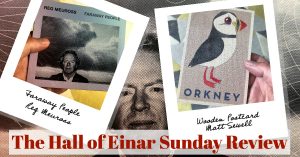 The Hall of Einar Sunday Review #15 Faraway People by Reg Meuross and The Wooden Postcard Company's Matt Sewell’s birds read more
The Hall of Einar Sunday Review #15 Faraway People by Reg Meuross and The Wooden Postcard Company's Matt Sewell’s birds read more